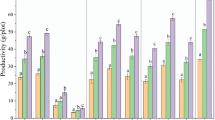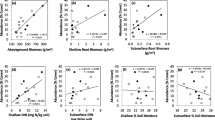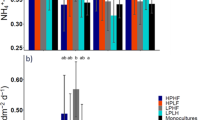Abstract
Plant species richness can increase primary production because plants occupy different niches or facilitate each other (“complementarity effects”) or because diverse mixtures have a greater chance of having more productive species (“selection effects”). To determine how complementarity and selection influence dune restoration, we established four types of plant communities [monocultures of sea oats (Uniola paniculata), bitter panicgrass (Panicum amarum) and saltmeadow cordgrass (Spartina patens) and the three-species mixture] under different soil treatments typical of dune restorations (addition of soil organic material, nutrients, both, or neither). This fully factorial design allowed us to determine if plant identity, diversity and soil treatments influenced the yield of both the planted species and species that recruited naturally (volunteers). Planted species responses in monocultures and mixtures varied among soil treatments. The composition of the plantings and soils also influenced the abundance of volunteers. The mixture of the three species had the lowest cover of volunteers. We also found that the effect of diversity on production increased with fertilizer. We partitioned the biodiversity effect into complementarity and selection effects and found that the increase in the diversity effect occurred because increased nutrients decreased dominance by the largest species and increased complementarity among species. Our findings suggest that different planting schemes can be used to meet specific goals of restoration (e.g., accelerate plant recovery while suppressing colonization of non-planted species).





Similar content being viewed by others
References
Aarssen LW (2003) Is the productivity of vegetation plots higher or lower when there are more species? Variable predictions from interaction of the ‘sampling effect’ and ‘competitive dominance effect’ on the habitat templet. Oikos 102:427–433
Au S (1974) Vegetation and ecological processes on Shackleford Bank, North Carolina. National Park Service, Washington, DC
Balvanera P, Pfisterer AB, Buchmann N, He JS, Nakashizuka T, Raffaelli D, Schmid B (2006) Quantifying the evidence for biodiversity effects on ecosystem functioning and services. Ecol Lett 9(10):1146–1156. doi:10.1111/j.1461-0248.2006.00963.x
Bertness MD, Callaway RM (1994) Positive interactions in communities. Trends Ecol Evol 9:191–193
Broome SW, Seneca ED, Woodhouse WWJ (1982) Building and stabilizing coastal dunes with vegetation. UNC Sea Grant Publication 82-05, Raleigh, NC
Bruno JF (2000) Facilitation of cobble beach plant communities through habitat modification by Spartina alterniflora. Ecology 81(5):1179–1192
Callaway RM (1995) Positive interactions among plants. Bot Rev 61(4):306–349
Cardinale BJ, Matulich KL, Hooper DU, Byrnes JE, Duffy E, Gamfeldt L, Balvanera P, O’Connor MI, Gonzalez A (2011) The functional role of producer diversity in ecosystems. Am J Bot 98(3):572–592. doi:10.3732/ajb.1000364
Copeland TE, Sluis W, Howe HF (2002) Fire season and dominance in an Illinois tallgrass prairie restoration. Restor Ecol 10:315–323
D’Antonio CM, Vitousek PM (1992) Biological invasions by exotic grasses, the grass fire cycle, and global change. Annu Rev Ecol Syst 23:63–87
Fox JW (2005) Interpreting the ‘selection effect’ of biodiversity on ecosystem function. Ecol Lett 8(8):846–856
Fridley JD (2002) Resource availability dominates and alters the relationship between species diversity and ecosystem productivity in experimental plant communities. Oecologia 132(2):271–277
Fridley JD (2003) Diversity effects on production in different light and fertility environments: an experiment with communities of annual plants. J Ecol 91(3):396–406
He JS, Bazzaz FA, Schmid B (2002) Interactive effects of diversity, nutrients and elevated CO(2) on experimental plant communities. Oikos 97(3):337–348. doi:10.1034/j.1600-0706.2002.970304.x
Hector A, Bazeley-White E, Loreau M, Otway S, Schmid B (2002) Overyielding in grassland communities: testing the sampling effect hypothesis with replicated biodiversity experiments. Ecol Lett 5(4):502–511
Hesp PA (1991) Ecological processes and plant adaptations on coastal dunes. J Arid Environ 21:165–191
Hooper DU, Chapin FS, Ewel JJ, Hector A, Inchausti P, Lavorel S, Lawton JH, Lodge DM, Loreau M, Naeem S, Schmid B, Setala H, Symstad AJ, Vandermeer J, Wardle DA (2005) Effects of biodiversity on ecosystem functioning: a consensus of current knowledge. Ecol Monogr 75(1):3–35
Huston MA (1997) Hidden treatments in ecological experiments: re-evaluating the ecosystem function of biodiversity. Oecologia 110(4):449–460
Kennedy TA, Naeem S, Howe KM, Knops JMH, Tilman D, Reich P (2002) Biodiversity as a barrier to ecological invasion. Nature 417(6889):636–638
Loreau M, Hector A (2001) Partitioning selection and complementarity in biodiversity experiments. Nature 412:72–76
Loreau M, Naeem S, Inchausti P, Bengtsson J, Grime JP, Hector A, Hooper DU, Huston MA, Raffaelli D, Schmid B, Tilman D, Wardle DA (2001) Ecology—biodiversity and ecosystem functioning: current knowledge and future challenges. Science 294(5543):804–808
Mitsch WJ, Wilson RF (1996) Improving the success of wetland creation and restoration with know-how, time, and self design. Ecol Appl 6:77–83
Naeem S, Knops JMH, Tilman D, Howe KM, Kennedy T, Gale S (2000) Plant diversity increases resistance to invasion in the absence of covarying extrinsic factors. Oikos 91(1):97–108
Oostings HJ, Billings WD (1942) Factors effecting vegetational zonation on coastal dunes. Ecology 23:131–142
Perrow MR, Davy AJ (2002) Handbook of Ecological Restoration. Cambridge University Press, New York
R Development Core Team (2012) R: A language and environment for statistical computing. http://www.R-project.org/
Rogers S, Nash D (2003) The Dune Book. North Carolina Sea Grant, Raleigh, NC
Sax DF, Stachowicz JJ, Brown JH, Bruno JF, Dawson MN, Gaines SD, Grosberg RK, HastingS A, Holt RD, Mayfield MM, O’Connor MI, Rice WR (2007) Ecological and evolutionary insights from species invasions. Trends Ecol Evol 22(9):465–471. doi:10.1016/j.tree.2007.06.009
Scherber C, Mwangi PN, Schmitz M, Scherer-Lorenzen M, Bessler H, Engels C, Eisenhauer N, Migunova VD, Scheu S, Weisser WW, Schulze ED, Schmid B (2010) Biodiversity and belowground interactions mediate community invasion resistance against a tall herb invader. J Plant Ecol UK 3(2):99–108. doi:10.1093/jpe/rtq003
Seabloom EW (2007) Compensation and teh stability of restored grassland communities. Ecol Appl 17:1876–1885
Suding KN, Gross KL, Houseman GR (2004) Alternative states and positive feedbacks in restoration ecology. Trends Ecol Evol 19:46–52
Tilman D, Reich PB, Knops J, Wedin D, Mielke T, Lehman C (2001) Diversity and productivity in a long-term grassland experiment. Science 294(5543):843–845
van der Valk AG (1974) Environmental factors controlling the distribution of forbs on coastal foredunes in Cape Hatteras National Seashore. Can J Bot Rev Canadienne De Botanique 52:1057–1073
Vitousek PM, walker LR, Whiteaker LD, Muellerdombois D, Matson PA (1987) Biological invasion by Myrica faya alters ecosystem development in Hawaii. Science 238:802–804
von Felten S, Schmid B (2008) Complementarity among species in horizontal versus vertical rooting space. J Plant Ecol UK 1(1):33–41. doi:10.1093/jpe.rtm006
Walmsley CA, Davy AJ (1997) The restoration of coastal shingle vegetation: effects of substrate on the establishment of container grown plants. J Appl Ecol 34:154–165
Wilson JB, Sykes MT (1999) Is zonation on coastal sand dunes determined primarily by sand burial or salt spray? Ecol Lett 2:233–236
Yachi S, Loreau M (1999) Biodiversity and ecosystem productivitiy in a fluctuating environment: the insurance hypothesis. Proceedings of the National Academy of Science 96:1463–1468
Acknowledgments
We thank the Coastal Studies Institute (Manteo, NC) and the North Carolina General Assembly for funding and logistical support, Nancy White and Mike Piehler for enthusiastic support, the National Park Service for access to the study site, and Katie Frank, Amy Long, and Jill C Fegley for help with establishing and sampling the experiment.
Author information
Authors and Affiliations
Corresponding author
Rights and permissions
About this article
Cite this article
Long, Z.T., Fegley, S.R. & Peterson, C.H. Fertilization and plant diversity accelerate primary succession and restoration of dune communities. Plant Ecol 214, 1419–1429 (2013). https://doi.org/10.1007/s11258-013-0263-1
Received:
Accepted:
Published:
Issue Date:
DOI: https://doi.org/10.1007/s11258-013-0263-1




